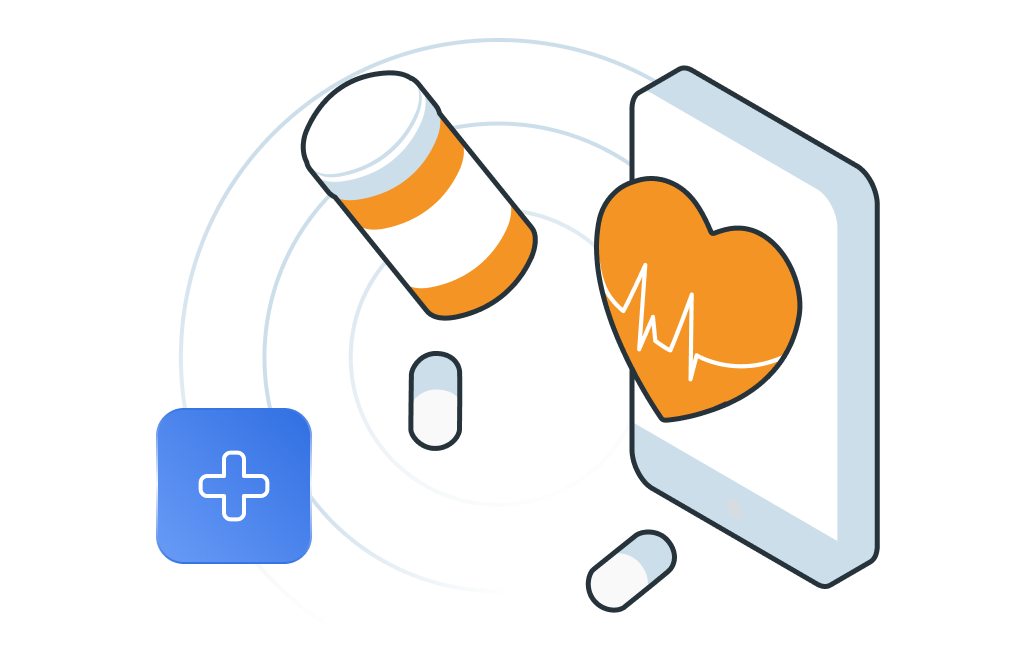
Remote Patient Monitoring in 2023: Trends and Challenges
Remote Patient Monitoring (RPM) has become a highly sought-after healthcare delivery model. Grand View Research predicts that RPM will become even more popular, with a global market worth of USD 4.4 billion in 2022 and an estimated Compound Annual Growth Rate (CAGR) of 18.5% until 2030. To provide you with a thorough overview of this growing phenomenon, in this blog post, we will dive into RPM in detail, explaining how Remote Patient Monitoring works and discussing its elements, benefits, and all potential challenges.
Table of Contents
What is Remote Patient Monitoring?
RPM is a healthcare delivery model that allows medical personnel remotely monitor and manage patients’ health by collecting data via connected devices. This includes tracking vital signs, symptoms, and medication adherence. The collected data is analyzed in a central monitoring system, and appropriate action is taken. This means patients don’t have to visit medical facilities in person, which is especially important for those with chronic conditions that require regular monitoring. RPM also helps healthcare providers detect potential health issues early, resulting in better health outcomes and lower healthcare costs. In fact, The University of Pittsburgh Medical Center, for example, reduced the risk of hospital readmissions by 76%.
How does remote patient monitoring work?
The following steps are usually included in the remote patient monitoring process:
Data collection
Patients utilize smartphone apps, wearable sensors, and other linked devices to track their activity levels, vital signs, and medication adherence.
Data Transmission
The gathered data is sent safely to a central monitoring system that healthcare professionals can access.
Data analysis
is carried out by healthcare professionals in order to identify potential health problems, make clinical judgments, and, if necessary, launch prompt actions.
Communication and Feedback
Healthcare providers communicate with patients and provide feedback based on the analyzed data. Patients can interact via the system with healthcare providers, asking questions and receiving guidance on managing their health conditions.
What are the components of remote patient monitoring system?
Remote patient monitoring systems consist of connected devices, a central monitoring system, and healthcare practitioners. Patients use wearables, sensors, and mobile apps to collect health data transmitted via cellular networks to the central monitoring system.
Devices such as fitness trackers, blood pressure monitors, and glucose monitors can track vital signs, including heart rate or oxygen levels, among others. The central monitoring system receives and analyzes the data collected by the connected devices in real-time. Healthcare practitioners use this information to spot changes in a patient’s health and provide personalized treatment plans.
Components of RPM systems:
- Medical device with a Bluetooth module
- Mobile app
- Cloud repository
- Hospital-side software
Remote Patient Monitoring Technologies
Remote patient monitoring in healthcare is advancing rapidly and now incorporates a range of sophisticated tools for collecting and analyzing health data. Currently, two technologies are dominant: both AI and the Internet of Things (IoT) are proving highly beneficial.
Remote Patient Monitoring and AI
Remote Patient Monitoring is using artificial intelligence, which results in more accurate and efficient health data processing. By analyzing large data sets, AI algorithms can spot patterns and abnormalities that human analysis would miss.
For example, It can easily identify early indicators of illness progression and deliver early therapies to prevent complications. Furthermore, by evaluating patient data in real-time and delivering predicted insights, AI can help medical professionals make accurate choices about how to treat patients.
Remote Patient Monitoring and IoT
Remote monitoring of chronic conditions
Individuals dealing with chronic illnesses like diabetes, hypertension, or heart disease can use IoT technology to monitor their conditions. Common devices are blood pressure monitors, glucometers, and heart rate monitors. They are gathering and sending patient data to healthcare providers for remote monitoring and management.
Fall detection
Wearables and smart home sensors are used for detecting falls and altering family members. It allows for quick medical intervention and lowers the risk of complications.
Medication adherence
By recording when patients take their medications and alerting them when it is time for their next dose, IoT devices can be used to track medication adherence.
Remote patient education
IoT devices can result in patients’ better understanding of their medical conditions and encourage them to take better care of themselves.
Lifestyle monitoring
We can monitor patients’ levels of sleep patterns, physical activity, and other factors that have the potential to have an impact on their health. Then, medical staff can create personalized care plans using this data and adapt them to each patient’s specific needs and goals.
Blurify: an example of successful healthcare project
Developing solutions for the healthcare sector requires a deep understanding of the medical domain. Blurify has proven to have the right approach while working on the healthcare solution for endometriosis patients.
The Finnish client wanted to build an application for pain management, daily health tracking, and value-based healthcare. Our team’s challenge was to create a cutting-edge app prototype that converted business requirements into a clickable prototype with intuitive features.
We analyzed all materials to help our client achieve his vision and conducted market research to generate new inspiration. We also designed the main mockups, focusing on features and user experience, and continue to work on more mockups as our cooperation progresses.
What are the challenges of remote patient monitoring?
Although RPM has the potential to revolutionize the healthcare sector, it currently faces some challenges in its adoption. Thus, before we implement the entire system, we need to be aware of some potential issues, including technical, regulatory, privacy, security, and technological illiteracy challenges.
Technical Challenges
Designing and implementing RPM systems can be a very demanding task. Major challenges in remote patient monitoring are related to systems that must be designed to capture, transmit, and analyze a wide range of health data accurately and in real-time. They must also be able to integrate with existing healthcare systems seamlessly. Achieving these objectives requires extensive IoT, data analytics, and software development expertise.
Regulatory Challenges
If you run an RPM system, you need to follow many rules that can be different depending on where you are. The Food and Drug Administration (FDA) is responsible for evaluating and inspecting medical devices in the United States. There are also two regulations in the European Union: the Medical Devices Regulation (MDR) and the In Vitro Diagnostic Regulation (IVDR).
Privacy and Security Challenges
You must also follow severe privacy rules. In the United States, for example, there is the Health Insurance Portability and Accountability Act (HIPAA). The GDPR, or General Data Protection Regulation, governs data protection in the European Union. These rules require businesses to have robust security preventing cybercriminals from compromising sensitive data.
To safeguard our data, we need to take some serious measures. For example, we can use encryption, safe storage, and secure data transmission. We also have to follow data privacy regulations like HIPAA in the US. This law makes it mandatory to protect patients’ privacy. Following these rules builds trust between patients and healthcare providers and helps with its widespread adoption.
What are the benefits of RPM?
RPM has been gaining popularity in recent years as it offers numerous benefits. One of its most significant advantages is improved patient outcomes. RPM allows them to be monitored continuously, enabling healthcare providers to catch potential health problems before they become severe. As a result, this proactive approach to healthcare can lead to both: significantly reduced hospitalizations and much lower mortality rates.
In addition, RPM also offers cost savings for healthcare providers. By monitoring patients remotely, healthcare providers can avoid the costs associated with hospital stays and emergency room visits. It also frees up medical resources that can be directed toward other areas of healthcare.
Another remote patient monitoring advantage is increased access to healthcare. For patients who live in remote areas or have mobility issues, RPM offers a way to receive healthcare without having to travel to a clinical setting. This is particularly beneficial for patients with chronic conditions that require ongoing monitoring.
The potential of RPM is significant. With such significant technological advancements, RPM is becoming more accessible and cost-effective. Additionally, the rise of telemedicine has further expanded the potential of RPM, as patients can receive virtual consultations with healthcare providers while being remotely monitored.
Remote patient monitoring – Key Takeaways
Remote patient monitoring importance is growing, having the potential to enhance patient outcomes, promote access to treatment, and save healthcare providers money. With such rapid technical improvements, RPM use is becoming more prevalent, and we anticipate it will play an increasingly more prominent role in the coming days.
However, it is important to note that the successful implementation depends on the software-based solutions. They must be reliable, user-friendly, and meet all formal requirements to ensure effectiveness. It is, therefore, crucial to partner with an experienced software house to develop and implement the remote patient monitoring system.
A specialized software company that knows the remote patient monitoring best practices makes sure the system is customized to fit the unique demands of healthcare professionals and patients and ensures it is integrated with existing healthcare systems in order to maximize its impact. Furthermore, such a system requires continual technical maintenance in order to make sure that it stays functional and up to date.
If you’re facing challenges related to RPM and software development, we at Blurify have a team of experts who can help you out. Our experienced team is well-equipped to handle any questions. Contact us to take advantage of our expertise in the field.








